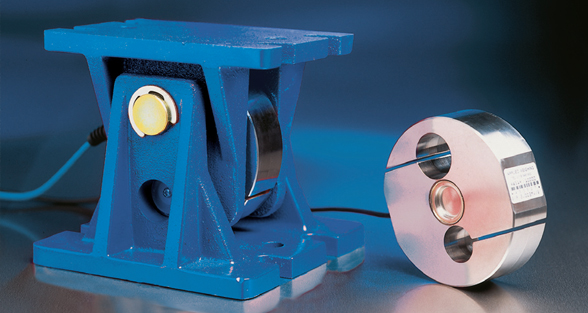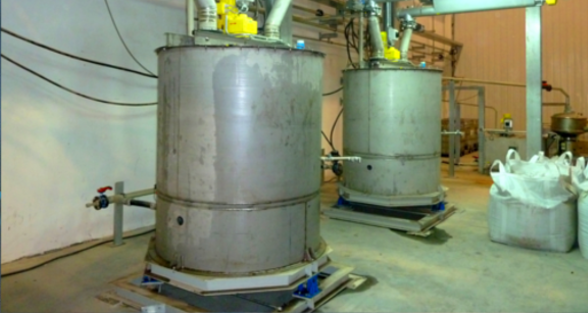TLC 95
The high-precision load cell for mixers and reactors
2,000 kg up to 10,000 kg (20.000 kg of request)
We work with you to optimise the design for weighing your mixers & reactors.
Place your request for a quotation now and we will be pleased to give you individual advice on your TLC 95 application.

Immediate advice: +49 (0) 29 61 – 96 56 86
AKW GmbH
Armacell GmbH
The added value to you
Stable
robust self-centring loading assembly
Optional
ATEX approval for Zones 1/21 and 2/22 (no barriers required for Zone 22)
Simple
Easy mounting
Approved for certification
Approved for OIML certification
Precise
Self-centring ensures high degree of measurement accuracy
High-quality
Stainless steel load cell (IP 67). Module with nylon coating or in stainless steel
Available option
Stainless steel module
Durable
3-year warranty
Why is the TLC 95 module the right choice for my plant?

With the benefit of our many years of experience we assist you in selecting the optimum weighing module for your application.
Place your request for an offer now and we will be pleased to help you:
+49 (0) 29 61 – 96 56 86
You are probably familiar with the following situation:
You require reliable content measurement for a tank, agitator or mixer.
You would like to dose formulations exactly – possibly even during mixing.
The mixer/reactor has a high tare weight.
The ideal solution:
The TLC 95 weighing module is suitable for tanks of 2 t up to 40 t.
The module can be screwed between the container support and the substructure. The module secures the mixer in all axes; however, it compensates for vibrations
The TLC 95 module is largely resistant to vibrations, dust, humidity and corrosion.
Upon request, we will gladly send you a series of information about our products, starting with the access to our data sheets.
How does the TLC 95 module work?
The TLC 95 weighing module contains a tension load cell.
This is suspended in the module in such a way that the pressure to be measured is converted into a tensile force.
Even where there are oscillations, the tare weight of the container ensures that the force is always introduced exactly vertically into the tension load cell.
The integral control system in the module is very insensitive to transverse forces, but it does allow a certain amount of thermal expansion.
The TCL 95 module has been developed specifically for mixing tanks.
Even when there are transverse forces and vibration, it offers outstanding dosing accuracy and zero-point stability.
Technical data
Measurement ranges:
2,000 kg, 5,000 kg and 10,000 kg (20.000 kg of request)
Total height:
174 mm
Supply:
5-12 VDC, max. 15 V
Output signal:
2 mV/V
Linearity error:
within 0.03% max.
Hysteresis:
within 0.02%
Reproducibility:
within 0.02%
Overload protection:
150% of the nominal load
Output resistance:
350 Ohm
Working temperature range:
-35°C to +80°C
Compensated Range:
-10°C to +45°C
Insulation resistance:
> 2,000 MOhm
Explosion approval [optional]:
ATEX Zones 1 and 2, 21 and 22 (Zone 22 without barriers)
Frequently asked questions
What is the difference between a weighing assembly and a load cell?
A load cell is the actual element, which measures the force. Standard load cells consist of a metallic body, which is deformed in a defined manner by the force applied.
The deformation is usually measured by metal DMS affixed to the cell and converted into a voltage signal. For small to medium forces bending or shear beams are usually used.
For larger forces as a rule cylindrical bodies or double-ended shear beams are used. When the load cell is loaded with a defined force, it emits a signal, which is proportional to the force (mV/V).
The weighing assembly´s function is to introduce the force into the load cell in the required direction. In the case of containers, the assembly´s function is to secure the container to the load cell and to prevent tilting.
In this way, the accuracy of the load cell should not be impaired, or should be only very slightly impaired. Some weighing modules have additional integral transport, installation and overload protection.
Irrespective of the accuracy of the load cell, the assembly is of primordial importance for the system accuracy of the weighing process.
On how many load cells may a silo, vessel or container be placed?
In order to obtain optimum accuracy, all support points should be weighed. There is no real limit to the number of load cells, apart from cost. Since the load should be distributed as evenly as possible, 3 or 4 supports are easier to balance than 12. Because of the parallel switching in analogue load cells, care must be taken that the measurement amplifier can supply the required number.
What is an anti-lift-off device?
An anti-lift-off device on silos and containers is used, for example, if wind loads or seismic loads have to be taken into account and there is a risk that the silo or the container may tilt over. In the case of wind, for example, in particular when the filling level is low, in relation to the weight of the silo the wind-exposed area is large, and it is then that the risk of tilting is greatest. There are weighing modules with integral anti-lift-off devices and others with separate anti-lift-off devices.
Integral anti-lift-off device:
The anti-lift-off device prevents the silo or container from tilting. The Safemount and Baby-Safemount weighing assemblies, which are used for silo weighing, have integral anti-lift-off devices. The top and bottom mounting plates in the assembly are connected to the load cell by bolt connections. In this way, the assembly compensates a certain expansion (e.g. caused by different thermal coefficients between steel and foundation materials) of the overall structure and also limits the distance that can occur in the case of a lifting silo.
Additional anti-lift-off device:
An additional anti-derail device is frequently used for load cells which do not have integral anti-lift-off devices. In this system, the anti-lift-off device can be attached to the load cell itself or directly to the silo or container. When statically required for the Safemount weighing assembly up to 40 t, additional anti-lift-off device, which are attached directly to the weighing assembly, are available. In this version, two vertical threaded rods are screwed into the bottom mounting plate. Each of these protrudes through a drilled hole in the top mounting plate without touching the plate. The maximum withdrawal distance is limited by a nut above the top plate at 2 – 3 mm and additionally secured by a lock nut.
What are stay rods?
Stay rods are needed for cylindrical load cells with what are known as self-aligning bearings, in order to prevent rotation of the container. The stay rods limit the horizontal movement of the container; however, they usually allow frictionless vertical movement.
What effects do wind loads have on accuracy of weighing?
Lateral forces, such as wind forces, largely balance out due to the parallel switching of the load cells. When one side of the silo is relieved of load by the wind, the load on the other side increases.
The sum of the forces therefore remains the same. Wind loads are identifiable only in case of strong gusts of wind, when the mean value creation (damping filter) of the measurement amplifier has been greatly reduced.
How far from the load cells may the measurement amplifier be located?
All „modern“ measurement amplifiers have what is known as a „sense“ input. In standard load cells only four conductors are required for measuring. These are two conductors for the supply (5 – 15V) and two conductors for the measurement signal.
If the measurement amplifier is located at a distance of more than 10 m, we recommend two additional conductors for the „sense“ line. The measurement amplifier „measures“ through the sense line how much voltage is dropped in routing and mathematically compensates for the voltage drop.
Where there is sufficient wire cross-section and separate transfer of the shielded connecting cable, distances of up to 200 m are feasible. For greater distances, we recommend the use of an amplifier on site at the silo or a bus connection via the Intelligent Junction Box.
